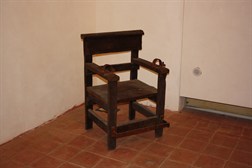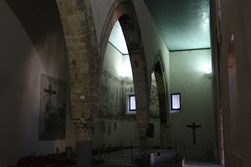Inside the Steri Palace: Carceri filippine, Sala Magna and the questioning
The main Sicilian families were linked to the Inquisition: especially for this reason all sensitive materials of the tribunal were burned after its abolition. During the Enlightenment, in the eighteenth century, also in Sicily no noble family wanted to be in some way related to an institution which was considered a retrograde repressive machine. With the burning it was possible to erase for decades the memory of having belonged to an organization that eighteenth-century aristocratic sensibility, nurtured by enlightened thoughts, considered repugnant. For nearly three centuries, however, the nobility was part of it. And perhaps it is for the prosecution of a noble that now we are in front of the door of the Steri Palace, behind the accused that will guide us in our journey.
 It is night, because the algozini captured prisoners under the cover of darkness. A notary accompanied them, who, while the person under investigation in chains was going towards the prison, carefully counted all his properties and goods, but also common tools. Since this moment, in fact, though he was in the hands of the inquisitors, the prisoner had to pay every thing necessary for his maintenance until the trial: food, straw mattress if he wanted one, the chair if he wanted to sit (photo), the doctors who visited him before and after the torture, the cloth and the manufacture for the realization of the sambenito, the garment of shame which he had to wear publicly. If at the end of the trial, he was judged as guilty, the temporary requisition made at the time of the arrest became definitive.
It is night, because the algozini captured prisoners under the cover of darkness. A notary accompanied them, who, while the person under investigation in chains was going towards the prison, carefully counted all his properties and goods, but also common tools. Since this moment, in fact, though he was in the hands of the inquisitors, the prisoner had to pay every thing necessary for his maintenance until the trial: food, straw mattress if he wanted one, the chair if he wanted to sit (photo), the doctors who visited him before and after the torture, the cloth and the manufacture for the realization of the sambenito, the garment of shame which he had to wear publicly. If at the end of the trial, he was judged as guilty, the temporary requisition made at the time of the arrest became definitive.
 The first place where the prisoner was conducted is located on the ground floor of the Steri Palace. It is the old Hall of Arms of the Chiaramonte family. In the seventeenth century, this environment was transformed into the so-called Carceri filippine (Philippine prisons), in honour of King Philip III: a large room painted with devotional subjects, probably commissioned by the inquisitors to induce repentance. In this room, the accused had time to reflect on his sins which, however, had not been yet reported to him.
The first place where the prisoner was conducted is located on the ground floor of the Steri Palace. It is the old Hall of Arms of the Chiaramonte family. In the seventeenth century, this environment was transformed into the so-called Carceri filippine (Philippine prisons), in honour of King Philip III: a large room painted with devotional subjects, probably commissioned by the inquisitors to induce repentance. In this room, the accused had time to reflect on his sins which, however, had not been yet reported to him.
He was then brought in the presence of the Inquisitor for the questioning, which took place in the most beautiful room of the Steri Palace: the Sala Magna, a huge space with a coffered ceiling with more than a hundred stories painted. They were episodes from the classic literature known in the Middle Ages and from courtly literature: they had in common the fact that at the center of the narrative there was always a female figure. Under the direction of the Prime Inquisitor, assisted by two others, in the presence of a notary writing down questions and answers carefully, sometimes in the presence of the alcalde, the police captain, the questioning began. The ritual required that the Prime Inquisitor warned the prisoner three times: at this point, the allegations were presented, but the testimonies were deprived of the most basic points of orientation for the accused (names of the witnesses, places and so on in order to protect the accusers). In order to obtain a confession the torture was used, the torture of the rope: the unfortunate was hanged to a pulley and then drop down violently, causing dislocations in the joints. Thanks to the torture a confession could be obtained, full proof of guilt. Torture could not last more than half an hour, but during this reduced time it is possible to completely dislocate a man and leave him sore or cripple, until the end of his days. Torture was given every forty-eight hours until the confession; at this point there was the judgment. Characteristic of inquisitorial justice was not to comply with the procedure followed in all the tribunals of Europe and which was derived from Roman law, that requires the publicity of the rules. Rules and forms of the inquisitorial trial remained secret, so it was not easy to determine a priori the lightness or severity of the sentence. Besides, during the questioning the accused could make statements that were annoying to the ears of the inquisitors and his situation could become worse.
The prisoner could be fulfilled, reconciled namely re-admitted to the ranks of believers with a slight penance, with the so-called abiura de levi (a public confession of his own faults, followed by a request for forgiveness), with the so-called abiura de vehementi (a sort of second baptism, which could be done only once in a lifetime) and a harsher penance, imprisonment for a specified time or service in the galleys. This last sentence, given the harshness of life of the rowers, was equivalent to the death penalty. Finally, in the case of particularly serious crimes, the investigators could release the accused to the secular arm. Because they were priests, they could not sentence to death; only the secular justice could do it, usually by burning. The sentences were made ??public during a solemn procession, the auto de fé.
